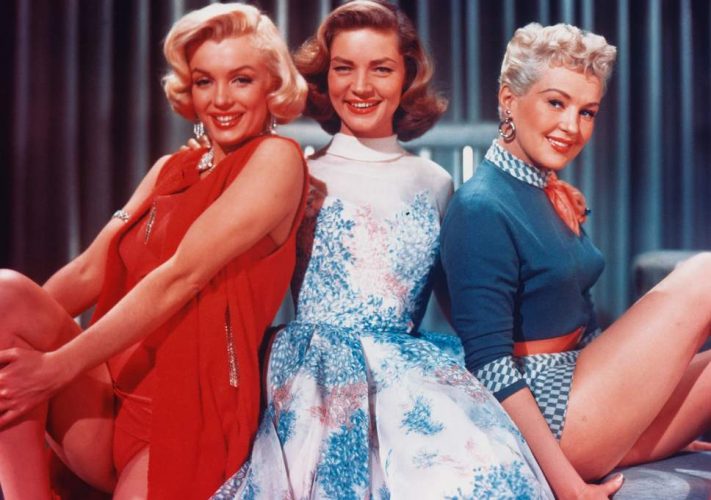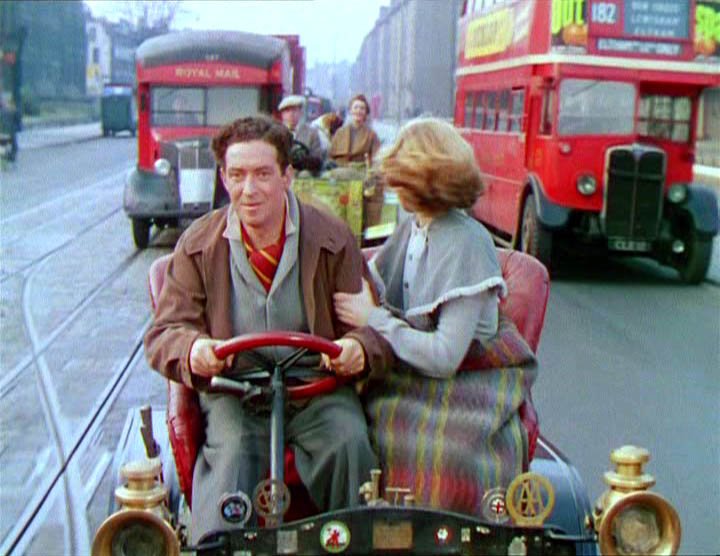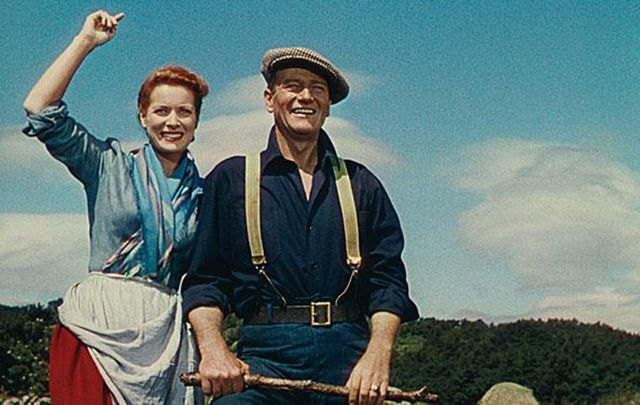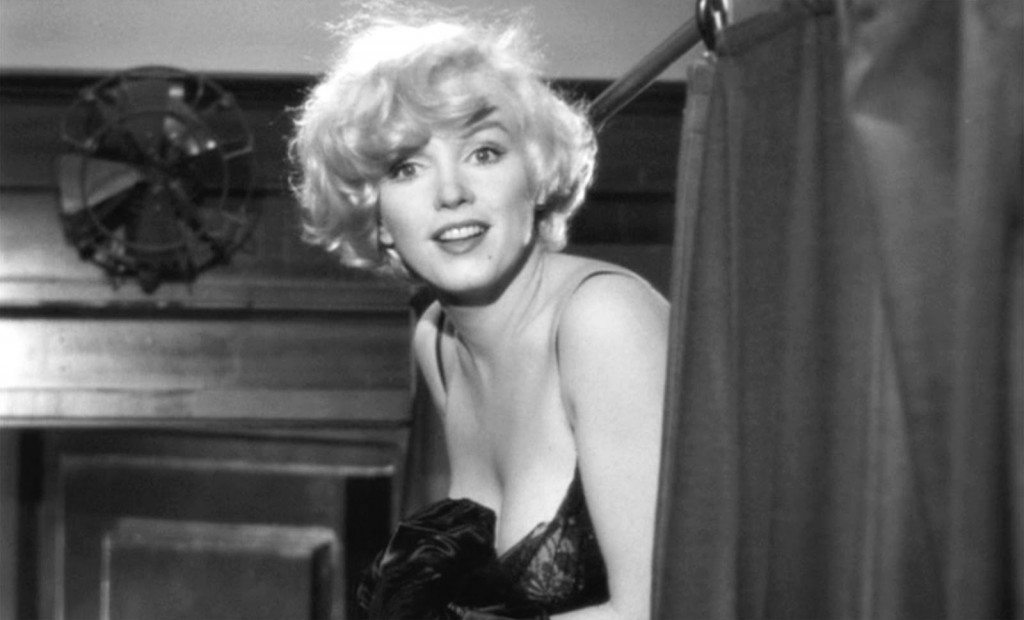Comedies in the 50s took a back seat to all other genres. In order to combat what was happening with the new tidal wave known as television, movie studios introduced the “bigger is better” code that would last through to the late sixties. It was the decade of large scale historical dramas, musicals, biblical epics – basically anything where you could fill a cinemascope screen and get people out of the house to see something they couldn’t see on the little box in the living room.
Films like ‘The Greatest Show on Earth’ (1952), ‘Shane’ and ‘The Robe’ (both 1953), ‘Oklahoma’ (1955), ‘The Ten Commandments’, ‘Giant’ and ‘The King and I’ (all 1956), ‘Bridge on the River Kwai’ (1957) and ‘Ben-Hur’ (1959) – as well as dozens of others – took advantage of the opportunity to visually overwhelm and, at the same time, try to make the spectacle work as part of the story. It didn’t always work (for every ‘Ben-Hur’ there was laughable fare like ‘The Prodigal’) but, more often than not, they made money.
If people wanted to laugh, the majority stayed home and turned to ‘I Love Lucy’, ‘Make Room for Daddy’, ‘The Honeymooners’, Sid Caesar and Milton Berle on the small screen. Film comedies had a harder time breaking through – they were too ordinary and antiseptic (‘Designing Woman’, ‘Love in the Afternoon’), and often not even remotely funny (anything with Martin and Lewis, ‘The Tunnel of Love’). That wasn’t the case with the thirties and forties and it wouldn’t be the case in subsequent decades. It was a tough slog for about 9 years, but there were some gems that do stand the test of time and they’re worth seeking out. Here’s a look at seven that still resonate and define the best of the decade in comedy:
7. How to Marry a Millionaire (1953)

There is no question that this one is very dated in its basic premise that all women are out to nab a man, preferably a rich one. But if taken as a true period piece, this is a very funny film and provided all three of its stars – Lauren Bacall, Betty Grable, Marilyn Monroe – with some of their best comedic opportunities. Showing off conspicuous consumption at its finest, the trio do their best to find the right guy, but ultimately love gets in the way. It’s all very silly, but there’s great dialogue and the three stars play beautifully together. Bacall is the no-nonsense leader of the group, Grable the more down-to-earth of the trio and Monroe is the stereotypical nearsighted blonde who exists in a perpetual comic haze. Key moments – Bacall shopping for jewelry (“I’ll take that … and that, and that and that and that.”), Grable dreaming of a pastrami sandwich and beer instead of money, and Monroe walking into walls because she won’t wear her glasses. It’s all handled with aplomb. Over the years, this one morphed into camp, but it remains a guilty pleasure that can still produce laughs.
6. The Long, Long Trailer (1954)

With the breakout success of ‘I Love Lucy’ on TV, Lucille Ball and Desi Arnaz come back to the big screen with ‘The Long, Long Trailer’ as true superstars, something they had never achieved in their film careers. Playing characters closely aligned to their television roles, the two found a perfect showcase for their talents in Vincente Minnelli’s beautifully photographed film. Although it does rely on some terrific slapstick for a lot of the humor (Ball’s forte and she doesn’t disappoint particularly in a crazy cooking scene), it’s also a surprisingly honest and funny depiction of newlyweds trying to make their new marriage work while hauling around a massive trailer to a prospective job site for Desi’s character. I had the opportunity to see this at a recent TCM event and what was always funny on a small screen became hysterical on a large screen. It was the biggest grossing comedy in MGM’s history up to that point, but it seems to have taken a backseat to Lucy’s success on television. It’s worth a look as a prime example of the MGM factory and Lucille Ball doing what they did best.
5. Pillow Talk (1959)

It looks naïve now, but in its time this was considered quite sophisticated fare. Doris Day plays a single, successful career woman not necessarily looking to find a husband – a definite departure for the era – but she’s wooed by a wolfish Rock Hudson, who’s pretending to be someone other than the arrogant guy on the other end of her telephone party line. It’s all very innocent yet still very funny. It presents an ultra-sophisticated view of living and loving in Manhattan with beautiful clothes and apartments but the home-run for this one are four truly funny performances. This was the first teaming of Day and Hudson and it’s clear they’re having a great time – he’s more playful than usual and she’s at the top of her game as a physical comedienne. They’re ably support by Thelma Ritter and Tony Randall in two scene-stealing performances. Both Day and Ritter received Oscar nominations and the screenplay won, although probably not deserved considering the competition included Bergman’s ‘Wild Strawberries’, Truffaut’s ‘The 400 Blows’, and ‘North by Northwest’. Still, one of the best comedies of the era and a nice throwback to the work that Myrna Loy and William Powell were doing in the thirties.
4. Genevieve (1953)

A great source for comedy in the fifties was the UK (The Lady Killers, The Lavender Hill Mob) and this fast-paced gem was a big hit in England and also did well in North America. Somewhat forgotten today, it’s the story of two couples who participate in a vintage car race from London to Brighton. The humor is a little more adult than usual for fifties American cinema, but there’s real wit and some wonderful slapstick as it tells its story. The breakout star here is Kay Kendall – a gorgeous comedienne who had a brief but brilliant run in the mid-fifties before an early death. With great location photography, a wonderful script and some very funny supporting performances, this is one of the films of the era that deserves to be rediscovered.
3. The Quiet Man (1952)

This is my favorite John Wayne performance and one of my favorite films of the decade. I’m not sure it’s a great film – the characters are a little to stereotypical, the story a little too pat – but it’s a comical gem that gifts us with an idealized look at life in an Irish town in the middle of the last century. Wayne plays a former prize fighter who returns to his birthplace with the hope of buying back his homestead and settling down. He soon encounters the various comical townsfolk as well as Maureen O’Hara and he’s smitten. The comedy here comes from leveraging the Irish reputation for both bluntness and sentiment. No one is afraid to speak their mind and everyone does. John Ford directed this with great affection for these people and it truly is the best, most romantic work that Wayne and O’Hara ever did.
2. Roman Holiday (1953)

The decade’s best romantic comedy and ultimately a real heart-breaker. It’s the story of a young princess (Audrey Hepburn in her first starring role) who manages to escape the eyes of her palace guardians while on a royal tour. She ventures off one night in Rome, meets a journalist (Gregory Peck) who sees her as the biggest scoop of his career if he can secretly report on and photograph her adventures around Rome. Of course they fall in love, and post-war Rome provides the perfect backdrop for both the comedy and the romance. Nicely directed by William Wyler for a great script by blacklisted Dalton Trumbo, it allows Peck to be more relaxed than usual. It also gives us Audrey Hepburn – probably the screen’s perfect princess, a lovely comedienne and one of the best actresses of the era. Hepburn won her only Oscar for this. Aside from the allure of Hepburn and Peck, It’s impossible to sit through this and not want to immediately head to Rome – it’s as much a love story with the city as it is about its two main characters.
1. Some Like It Hot (1959)

This is the big comedy of the decade and probably near the top of the list of everyone’s favorite comedy of all-time. It’s still spectacularly funny with dialogue that pushes the envelope of sexual boundaries in a way that wasn’t seen before and quite ground breaking for the late fifties. Billy Wilder’s best film tells the story of two musicians who, upon witnessing the St. Valentine’s Day Massacre, decide to dress as women and join an all girl band to get out of town. From there the layers of mistaken identity, sexual identity and just plain silliness bubble up to make the era’s best screwball comedy. Jack Lemmon and Tony Curtis are both hysterical, with Lemmon taking the edge by allowing his character to enjoy the charade a little too much (the last line in the movie is perfection). It also has Marilyn Monroe playing the ultimate Monroe character – beautiful, a little dumb, a little wounded, but with just enough street smarts to ensure she doesn’t come across as helpless – one of her definitive performances. But this movie belongs to the men, including Joe E. Brown who is wonderful as Lemmon’s older rich “boyfriend”.
There were other comedies of note from the decade – the film adaptation of the Broadway hit ‘Born Yesterday’ (1950), Billy Wilder’s romantic ‘Sabrina’ (1954), the elephantine ‘Around the World in 80 Days’ (1956), and ‘It Happened to Jane’ (1959), a really good one with Jack Lemmon and Doris Day that sank very quickly after opening – but thankfully a better decade was about to be ushered in with ‘The Apartment’.
Read More: Best Sex Comedies of All Time

